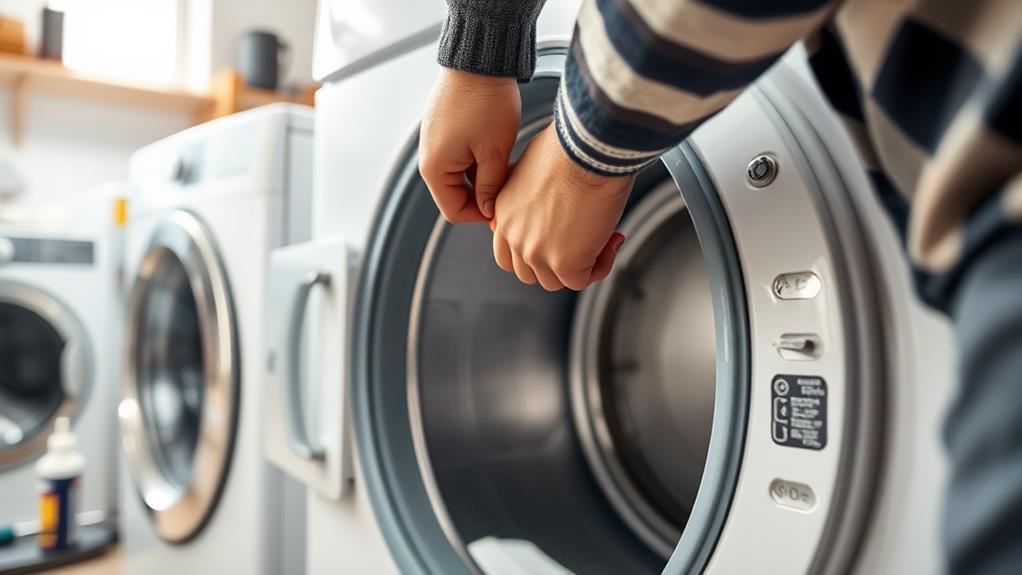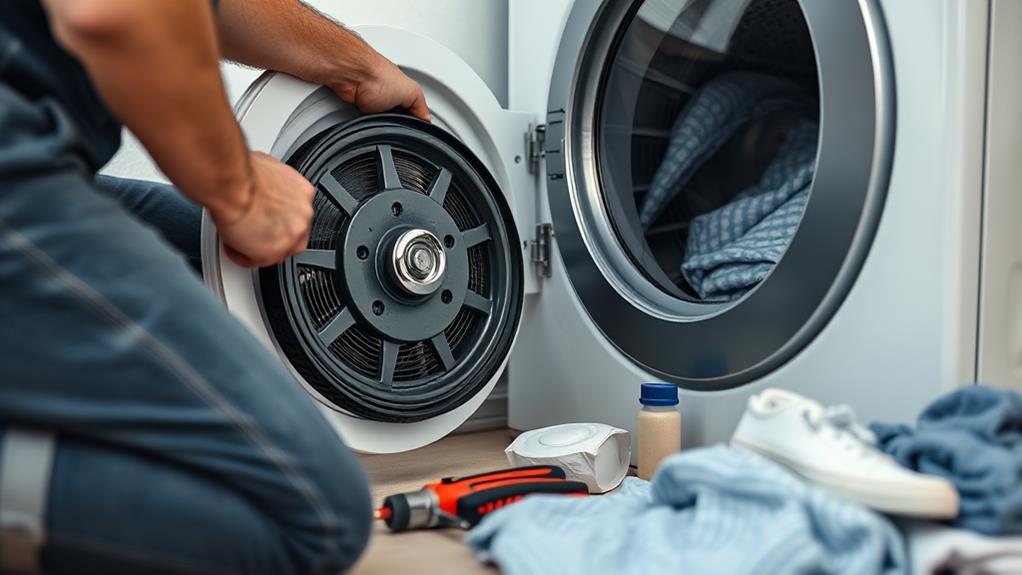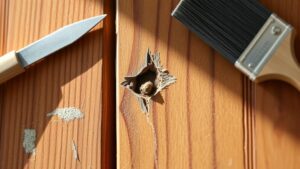To fix your squeaky dryer without calling a repairman, start by identifying the noise's source. Check the level of your dryer; adjusting its legs can solve installation-related squeaks. Next, inspect the drive belt for frays or cracks and replace it if necessary. Lubricate the drum bearings and tighten the idler pulley if it's loose. Don't forget to look for foreign objects causing friction. Regular cleaning and maintenance can prevent future issues. By taking these steps, you can enjoy a quieter laundry experience. Interested in more tips and tricks to keep your dryer in top shape?
Common Causes of Squeaking
A squeaky dryer can be quite frustrating, and understanding the common causes can help you pinpoint the issue. One of the most common reasons for squeaking is an unlevel installation, which can create noise as the dryer drum rotates. If your dryer isn't sitting evenly, it might be time to adjust its legs.
Additionally, ensuring that your financial management is streamlined can help prevent unnecessary stress when dealing with home repairs, much like how expense tracking apps can simplify your finances.
Another culprit could be worn or damaged drum bearings. If you hear squeaking, these might need lubrication or replacement. Similarly, if the drive belt is frayed or cracked, it can produce noise during the drum's rotation, indicating it's time for inspection and potential replacement.
Don't overlook the idler pulley! A malfunctioning idler pulley can also squeak if it's loose or broken, and repairing or replacing it can restore quiet operation.
Diagnosing the Problem
Diagnosing your dryer's squeak starts with locating the source of the noise. A squeaking dryer can produce sounds from the top, back, or bottom, each indicating specific issues.
Begin your visual inspection by checking the dryer belt for signs of wear, like fraying or stretching. A loose or damaged dryer belt is a common culprit of squeaking. To avoid complications from missed payments, consider adopting efficient bill tracking strategies that can help you stay organized and proactive in managing your finances.
Next, examine the idler pulley; if it's loose or broken, it can also create annoying noises.
Don't forget to inspect the drum bearings and rollers, as worn or poorly lubricated components can lead to unwanted sounds when the drum rotates.
Finally, look for any foreign objects lodged in the lint trap or blower wheel. These items can cause friction and contribute to the squeaking issue.
Step-by-Step Fixes

Once you've identified the source of the squeak, it's time to tackle the repairs. Start by unplugging your dryer and leveling it to guarantee uneven installation isn't causing the squeaking noises.
Additionally, using proper tools can help make the repair process smoother, similar to how expense tracking tools streamline financial management for entrepreneurs.
Next, inspect the dryer belt for any signs of damage, like fraying or cracks. If you find any, replace it with a new one to fix the problem.
Then, check the drum bearings for wear. If they're worn out, lubricate them or replace them with new ones to restore smooth operation.
Don't forget to examine the idler pulley; if it's loose or damaged, tighten it or replace it as needed to stop those annoying sounds.
Maintenance Tips
Keeping your dryer in top shape is essential for preventing squeaks and guaranteeing efficient operation. Regular maintenance can save you from a noisy, squeaky dryer and keep it running smoothly.
Additionally, using expense management apps can simplify your financial tracking while you focus on home maintenance tasks. Here are some key maintenance tips to follow:
- Clean the lint trap after each use to prevent buildup that can cause friction and noise.
- Inspect the dryer belt periodically for signs of wear, like cracking or fraying, and replace it as needed.
- Lubricate drum rollers and idler pulleys to guarantee smooth movement and reduce unwanted sounds.
- Check and adjust the dryer legs to keep the appliance level, which helps minimize noise issues.
When to Seek Help

Even with regular maintenance, there are times when you might need to call in a professional for your squeaky dryer. If the dryer continues squeaking after you've cleaned the lint trap and guaranteed it's level, it could indicate deeper issues.
You should seek help when you notice persistent noise after replacing components like the dryer belt or idler pulley; this suggests common reasons like mechanical problems that need a licensed appliance technician's expertise. Additionally, confirming you have clear payment terms can help you manage any service costs effectively.
If you hear a grinding noise from the dryer motor or notice any signs of damage, like overheating, it's vital to consult a technician. Ignoring these symptoms can lead to fire hazards or more extensive damage.
If you see excessive wear on multiple components, such as the drum bearings and rollers, don't hesitate to call for professional assessment. Attempting to fix complex issues without the right knowledge can worsen the situation.
Knowing when to seek help can save you time, money, and potential safety risks. Always prioritize your safety and the longevity of your appliance by getting professional assistance when needed.
Preventative Measures
To keep your dryer running quietly, establish a regular cleaning schedule for the lint trap to prevent buildup.
Regular maintenance can improve your appliance's performance and reduce the risk of costly repairs, similar to how a budgeting app can help maintain financial health by tracking expenses and savings goals financial management tools.
You should also make sure your dryer is properly leveled, as an uneven setup can cause unnecessary noise.
Regular Cleaning Schedule
Establishing a regular cleaning schedule for your dryer not only enhances its performance but also prevents annoying squeaks from developing over time.
By staying proactive with maintenance, you can avoid calling a repair person to address squeaky issues caused by lint buildup and other debris.
Here are some key steps to include in your routine:
- Clean the lint trap after each use to guarantee maximum airflow and reduce friction.
- Vacuum around and underneath the dryer every month to eliminate lint buildup that can interfere with the drum glide and roller wheels.
- Inspect and clean the dryer vent ducts quarterly to prevent clogs and potential overheating.
- Schedule a deep cleaning of internal components, like the blower wheel and drum, at least once a year.
Proper Leveling Techniques
Ensuring your dryer is properly leveled is essential for preventing annoying squeaks and vibrations during operation. To start, grab a level tool and check that your dryer is on a flat surface. If you find it's uneven, you'll need to adjust the dryer legs—screw them in or out until all four corners firmly touch the floor. This simple fix can considerably reduce noise while your appliance runs.
Next, make sure to tighten any loose dryer feet to stabilize the unit. Loose feet can cause unnecessary movement, leading to more noise over time.
It's a good idea to regularly inspect the installation area, too. Floors can settle or shift, which might affect your dryer's level. If you notice any changes, take the time to readjust your dryer.
Additional Resources

To keep your dryer running smoothly, it's crucial to know some maintenance tips and common DIY repairs.
You'll also want to recognize when it's time to seek professional help.
Let's explore these resources to help you tackle any squeaky dryer issues effectively.
Maintenance Tips Overview
When it comes to keeping your dryer in top shape, incorporating regular maintenance practices can make a significant difference in performance and longevity.
A squeaky dryer can often signal underlying issues, so addressing these can help you avoid costly repairs.
Here are some essential maintenance tips to take into account:
- Clean the lint trap after each use to prevent buildup that can cause friction and noise.
- Inspect the dryer belt regularly for wear signs like cracking or fraying; if it looks damaged, it may need to be replaced.
- Lubricate the drum rollers and idler pulley to guarantee smooth operation and minimize noise during drying cycles.
- Check the dryer's leveling; use a level tool and adjust the legs as needed to reduce vibrations.
Common DIY Repairs
Addressing the squeaks your dryer makes often involves simple DIY repairs you can handle yourself.
First, inspect the dryer belt for signs of wear. If you notice any fraying or cracking, it's time to replace it to eliminate that annoying squeaking sound.
Next, check the drum glide bearings; if they're worn out, replacing them will restore smooth drum movement and quiet functionality.
Don't forget to regularly lubricate the idler pulley to prevent squeaking, but steer clear of WD-40 due to its fire risks. Instead, use a suitable lubricant recommended by your dryer's manufacturer.
Another important step is to guarantee your dryer is level. Adjust the legs if needed, as an unlevel installation can contribute to excessive noise during operation.
When to Seek Help
Sometimes, despite your best DIY efforts, the squeaking from your dryer just won't go away. If you find yourself in this predicament, it might be time to seek help from a professional. Ignoring the issue can lead to further damage, so be on the lookout for these warning signs:
- Persistent noise after lubrication
- Visible wear on parts
- Unusual smells during operation
- Performance issues like overheating
If your dryer's noise is still loud, or if there are any broken or loose components, a qualified technician is your best bet. They can accurately diagnose complex issues that might be causing the noise, such as motor malfunctions or internal failures that you may not spot during your DIY inspection.
Consulting the dryer's product manual can also provide insights into whether the problem is beyond basic maintenance.
For intricate repairs, especially those involving electrical components, it's crucial to contact a professional. This guarantees your safety and compliance with local regulations, allowing you to get your dryer back in working order without unnecessary risks.
Don't hesitate to reach out for professional assistance when needed!
Conclusion
Now that you've unraveled the mystery of your squeaky dryer, you can breathe easy knowing you've taken the reins of your appliance repair. With a little elbow grease and a dash of patience, you've silenced the racket that once echoed through your home. Just remember, keeping your dryer in tip-top shape is like tending a garden; a bit of regular care goes a long way. So, embrace the quiet and enjoy your freshly dried laundry!



